This article will explore the unique role that text plays in vaporwave music and art. Why do vaporwave tracks, albums, and artist names use stretched out fullwidth text, Japanese writing 変, and 𐒖Ƭᖇ𝚫ƝǤⵟ looking Unicode characters? Why are track titles sometimes formatted to look like FILENAME.AVI or Muzak Corp™ Song Title?
Analyzing the text characters that accompany vaporwave can help us understand vaporwave a whole. How so? In her book "Because Internet", linguist Gretchen McCulloch compares the challenges of analyzing speech at scale, with the ease of analyzing internet writing. Speech requires time and resources to decipher and process. Internet language, on the other hand, is easier to work with. Because text on the internet is public and digitized, McCulloch says it readily "brings new insight to classic linguistic questions".
The same logic applies to vaporwave. While scholars, podcasters, YouTubers, and music fans have worked to decipher vaporwave's sounds and images... we will focus on the text.
We've analyzed the text that accompanies more than 800,000 vaporwave tracks, from 2010 to present day. We've scraped track titles, album titles, artists names, and metadata from SoundCloud and Bandcamp; to learn how how vaporwave came to be, how the aesthetic has evolved, and where its headed next.
We have a YouTube video exploring many of the same ideas in this article. If you prefer watching to reading, you can check out the video below.
Also, if you're just looking for our vaporwave text generator, you can find that tool here. Otherwise, read on...
- What is vaporwave?
- What is Unicode?
- Vaporwave ❤️ Unicode text
- Compared to synthwave
- Text encoding in the 80's and 90's
- Japan's impact on vaporwave 音楽
- Is vaporwave racist?
- Japanese halfwidth and fullwidth forms
- A quick aside on language, grammar, and Unicode correctness
- Beyond fullwidth
- Corporate offices, malls, and the nostalgia factories™
- Nostalgia.exe
- ANSI & ASCII art
- Math ≠ 𝙼𝒂𝔱𝕙
- Is vaporwave dead?
What is vaporwave?
Vaporwave is an art movement, born in the early 2010s, that often toys with feelings of nostalgia, dream states, decay, the mundane, longing for pasts that never existed, and for futures that will never arrive. It is sometimes viewed as a meme, sometimes doused in irony, and sometimes interpreted as a serious critique of capitalism. It can be all of (or none of) these things.
The music of vaporwave samples sounds from the 80s and 90s; and processes them to sound like they're coming from degraded VHS tapes, from distant shopping malls, and from fading memories. Pop songs, ad jingles, weather channel muzak, and corporate training materials are slowed-down, distorted, drenched in reverb, and layered alongside warbly synths and flutters of dissonance, leaving the listener with an almost warm-fuzzy feeling.
The visual art associated with vaporwave intertwines vintage computer graphics, pop culture references, pink and teal gradients, classic video games, hazy skylines, all too-perfect shopping mall interiors, late night 1980s television ads, corporate jargon, Greek busts, and Japanese. Often, these elements are filtered and glitched, appearing as relics from a future we dreamed of -- before that dream faded from memory.
The vaporwave aesthetic extends beyond the music, the album covers, and the music videos... to the text itself.
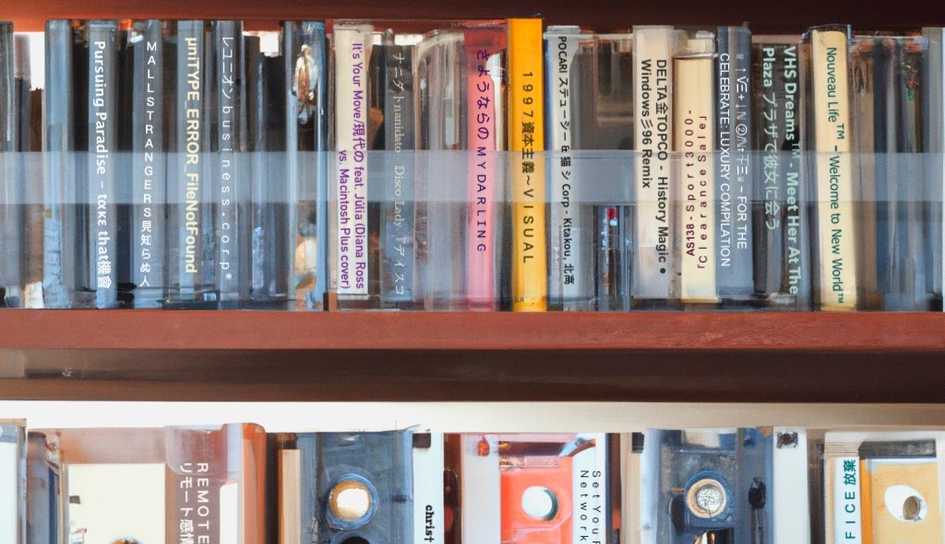
Vaporwave text is a strange poetry. Artist names, album titles, track titles, and bios contain text that serves to amplify many of the feelings that vaporwave music and visual art draw out of us.
Through text, the same feelings of nostalgia, lost futures, and decay can be achieved. This is done using rare Unicode characters, emojis, and strings of text that are broken and beautiful.
Some vaporwave tracks titles like Okinawa Sunset, Ocean Beach Highschool Prom 1984, Condominium Living, and We Apologise For The Inconvenience don't employ any text sorcery at all. They simply pair written word with recorded sounds to elicit feelings of lost futures, dream states, and nostalgia.
With other track titles, the text itself appears glitched, degraded, and echoed. Track titles like 沙灘 m i A M i // h–Or/r.er are unsettling in part because they are unpronounceable and can't readily be typed from memory. A track with a title like that can pop up on shuffle, worm its way into our ears, and then just disappear forever.
According to Scientific American "Many people find they can't read text in dreams. If they see text, it's almost always garbled or hieroglyphics or doesn't make sense or it's fuzzy." Track names like マRイ·EハTートUをR返Nす elicit those same dreamlike feelings through the breakdown of language.
In the charts below, we can see vaporwave's trajectory through time. We see the growth and decline in track releases on SoundCloud and Bandcamp, interest from Google search volume, and active community engagement based on Reddit post count.

These charts only tell part of vaporwave's story. In this article, we will analyze vaporwave's tapestry of letters, squiggles, shapes, and other Unicode characters. Like the music itself, the use of these text characters has changed over time.
As we dissect the text used in vaporwave, we can gain greater insight into movement's origins and how it is mutating.
But first, in order to understand how these text characters are rendered, we must understand Unicode...
What is Unicode?
Unicode is a text encoding standard. Unicode's goal is to assign every letter, number, and symbol in every language in the universe a unique code. Unicode is the de-facto system that computers use for encoding and representing text. There are currently 149,186 different Unicode characters in existence. For example: the code for lowercase "v" is U+0076, the code for the sunglasses emoji 😎 is U+1F60E, and the code for the infinity symbol ∞ is U+221E.
These codes are organized into categories called Unicode blocks. The letter "v" is in the "Basic Latin" block, the sunglasses emoji is in the "Emoticons" block, and the infinity symbol is in the "Mathematical Operators" block.
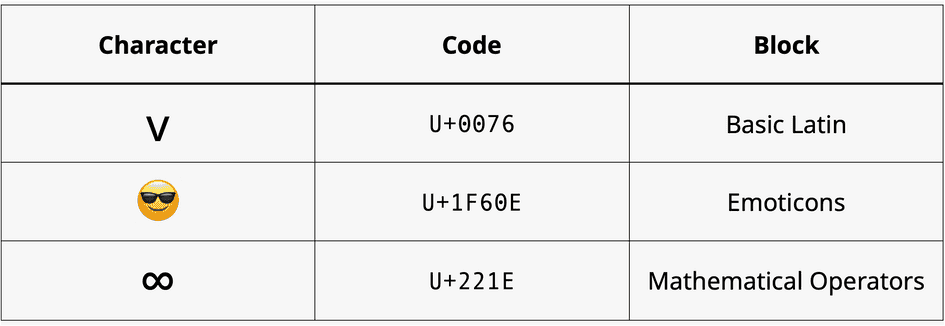
Vaporwave ❤️ Unicode text
While track titles in other musical genres mostly use the "Basic Latin" Unicode block (for English and European language song titles), vaporwave is different. Most vaporwave tracks do contain English language letters, but they exist alongside characters from many other blocks.
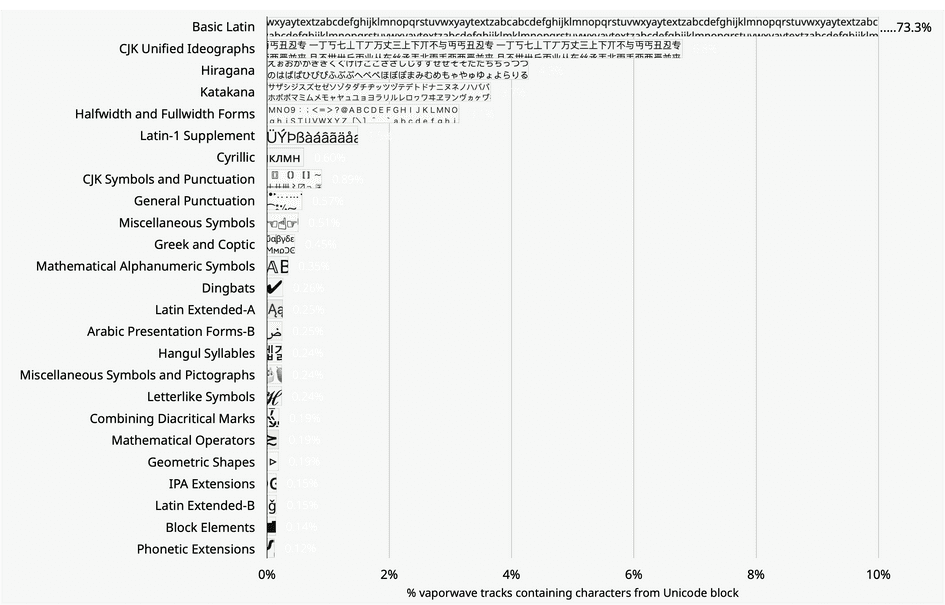
Aside from Basic Latin, vaporwave tracks make heavy use of CJK (Chinese, Japanese, & Korean) characters, halfwidth and fullwidth forms, and characters from a plethora of other blocks.
Here are some examples of track titles that use vaporwave's most common Unicode block combination: Basic Latin, CJK characters, and fullwidth / halfwidth characters.
- No Hard Feelings// 美的 Deluxe Edition
- TURING機械
- Anri - Remember Summer Days (マクロスMACROSS 82 - 99 Bootleg)
- ストレートWindowsからミック
Why do vaporwave tracks use characters from so many unusual blocks? Why are CJK and fullwidth characters used so frequently? Great questions. Read on...
Compared to synthwave
In our analysis, it's useful to compare vaporwave to its closest musical cousin, synthwave. Musicians will often straddle vaporwave and synthwave designations, and the sounds of these two genres sometimes overlap. Though their borders are blurry, vaporwave and synthwave are very different.
The Aesthetics Wiki notes, while "vaporwave can tend to have a more tongue-in-cheek and sarcastic tone to it, synthwave is incredibly earnest with its love of everything 80s and is made in tribute to the era rather than critiquing it."
Here, Reddit user Yutoob12 explains the difference:
Vaporwave is generally lighter colors, old computers, capitalism and greco roman statues. Synthwave is more neon, dark, sports cars, and tron grids.
Reddit user gronke describes the distinction as follows:
Synthwave is designed to emulate classic 80s themes and has an aesthetic of fast cars, faster women, and Miami sunsets. Vaporwave is totally different. It's more of a sarcastic cynical take on commercialized elements of the 90s. There are samples of jingles and pop culture clips. The music is designed to evoke a sense of familiarity with that time but in a more nightmarish sense.
The difference between vaporwave and synthwave isn't only noticeable in the music and on album covers. The difference can also be spotted in each genre's use of Unicode text.
About 25% of vaporwave tracks produced between 2012 and 2017 contain non-Latin characters in their titles. In more recent years, this number has decreased a little, hovering between 10% and 20%. Compare this to synthwave, where only a small fraction, about 5%, of track titles contain text that isn't from the Latin Unicode block.

Synthwave uses fewer fullwidth and CJK Unicode characters. The most common blocks found in synthwave, after Basic Latin, are Latin-1 Supplement, and Cyrillic.
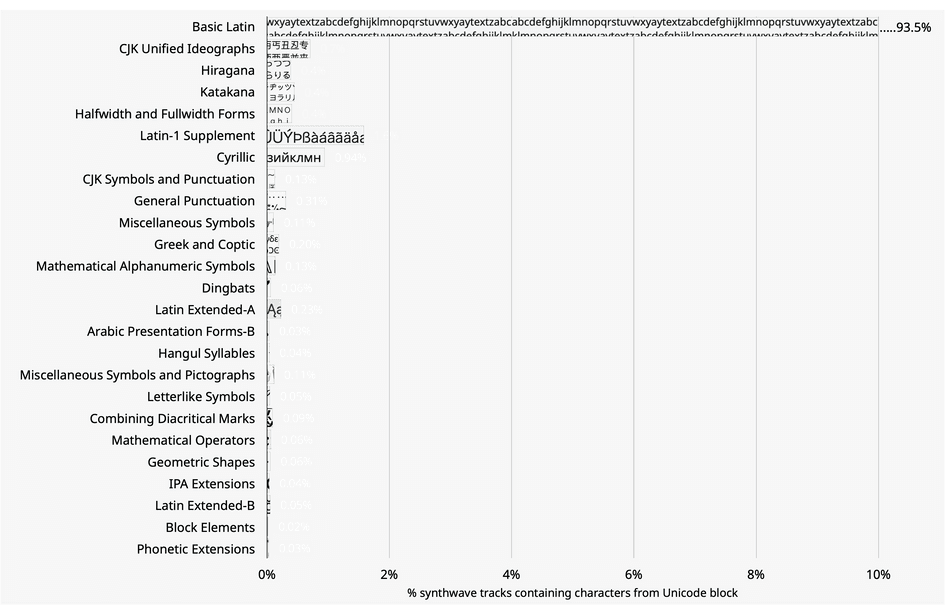
As you might have guessed, synthwave tracks are also less likely to mix-and-match characters from multiple Unicode blocks. 95% of synthwave track titles use characters from only a single Unicode Block (usually Basic Latin). Compare that to vaporwave, where more than 15% of song titles use Unicode characters from at least two different Unicode blocks.

While few vaporwave tracks use characters from more than 6 different Unicode blocks, they do exist. Here are some song titles where a higher than average number of distinct Unicode blocks are used:
| Track Title | Blocks / Characters |
|---|---|
| 12. DOS 93 vs ЌỖβÃϻǗŇĮŤẸĎ - 生意気な少年酔っAutan(残念屋のおばビーニャ - 一緒の男の子) | Basic Latin (26), CJK Unified Ideographs (13), Hiragana (7), Latin Extended-A (4), Katakana (4), Latin Extended Additional (2), Halfwidth and Fullwidth Forms (2), Greek and Coptic (2), Latin-1 Supplement (1), Latin Extended-B (1), Cyrillic (1) |
| 10. MYSTI©▲LVIΣW - M▲STΣ® 3D™ ☁ 世界はスーパーマーケットです | Basic Latin (24), Katakana (9), Hiragana (3), Latin-1 Supplement (2), Greek and Coptic (2), Geometric Shapes (2), CJK Unified Ideographs (2), Miscellaneous Symbols (1), Letterlike Symbols (1) |
| ♕Dℛ↑ѶΞ+↓ℕ ②/ℕ↑⏇Ξ♕ ~ FOR THE CELEBRATE: LUXURY COMPILATION | Basic Latin (43), Letterlike Symbols (3), Arrows (3), Miscellaneous Symbols (2), Greek and Coptic (2), Miscellaneous Technical (1), Halfwidth and Fullwidth Forms (1), Enclosed Alphanumerics (1), Cyrillic (1) |
| t e l e p a t h テレパシー能力者 and Phoenix #2772 - LOVE 私を忘れないでください | Basic Latin (39), Hiragana (9), Katakana (5), CJK Unified Ideographs (5), Halfwidth and Fullwidth Forms (4), Arabic Presentation Forms-B (1) |
| ナニダトnanidato - Doki Doki No Disco ドキドキのディスコ 『FUTUREFUNK』 X 甘い日本のディスコ'89 | Basic Latin (37), Katakana (16), Halfwidth and Fullwidth Forms (10), Hiragana (3), CJK Unified Ideographs (3), CJK Symbols and Punctuation (2) |
Throughout this article, we'll continue to compare vaporwave's use of text with synthwave, to demonstrate the unique nature of the genre, even when compared to a similar style of music.
Text encoding in the 80's and 90's
Prior to Unicode becoming the standard, multiple competing text encoding standards were in use. In the 80s and 90s, the decades that most influenced vaporwave, there was no single prevailing text encoding standard.
To understand how the absence of the Unicode standard relates to vaporwave, let's briefly digress, and talk about Windows 95.
Microsoft's Windows 95 operating system makes countless appearances in vaporwave. Its startup sound is famously sampled on Blank Banshee 0, an album that Fader magazine called a "definitive [document] of the vaporwave era".
There are namesake albums like ♣ Windows 95 ♣ by VIRTUALファンクに近いです and Overton Windows 95 by Datavoid. The operating system's user interfaces and logo appear across a swath of album covers including HIRAETH by 猫 シ Corp., Virtual Dreams by Virtualsoft Home, and the post-vaporwave / post-irony album Welcome to Windows 95 ya c--- by ĐΔŇ.
There are vaporwave artists who go by the non-existent Windows96 and the OS's successor Windows 98のご紹介. The Windows 95 logo is even incorporated into the featured image on the vaporwave Wikipedia page.
Why is Windows 95 so present in vaporwave? Reddit user WarpCrow, credits "the dated corporate aesthetic" and Microsoft's "idealistic marketing". According to Forbes magazine, Windows 95 was "the most important operating system of all time [...] Compared to its predecessor, Windows 3.1, it was like using something from the future."
So... did Windows 95, the darling OS of vaporwave, support Unicode? The answer is no. Windows 95 used ANSI encodings.
The Apple IIGS used ASCII. Mac computers, prior to OSX, used an encoding based on ASCII called Mac OS Roman. Meanwhile in Japan, text was encoded with the JIS X 0201, JIS X 0208, or Shift JIS standards. The default character set for older versions HTML was ISO-8859.... and so on... All of these technologies eventually adopted Unicode, but not before things got messy.
When the MP3 gained popularity in the 90s, music wasn't accessed from centralized organized repositories like the iTunes Music Store or Spotify. Instead music was ripped, uploaded, tagged, downloaded, and burned to CD over and over -- across systems with no agreed upon text encoding standard. Garbled text (aka mojibake) was a common occurrence.
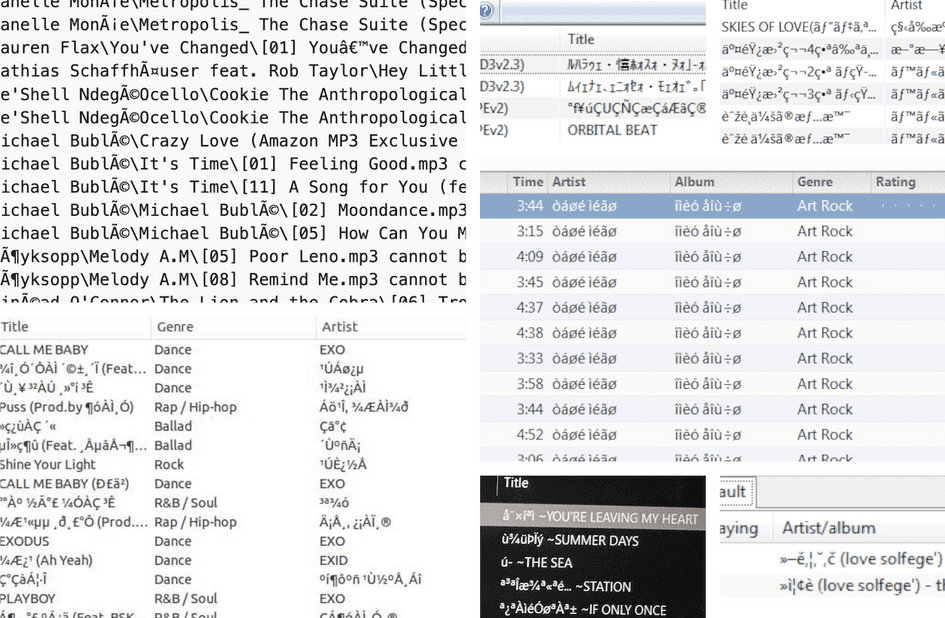
Some vaporwave text appears to be glitchy and badly encoded on purpose, playing into themes of both nostalgia and decay; transporting the listener back to the days of Limewire, Napster, and Winamp; to the days of sitting in a college dorm room, manually, painstaking organizing ID3 tags and wondering why the hell you've got MP3s that say "Guns n’ Roses" and "Bjöork".
Here are some track titles that purposely look like common text encoding problems. Be warned, some of these tracks are a little post-vaporwave and even veer into the harsh noise genre.
- ÅÅåÅåÅÅ
- Ãþº¾^@^@^@2^@
- áOV═Å«╜lL}∩3╙zR.2eVí@æxë
- 🃤 â–’ ğŸ˜â™ ğŸ—
- „•â Žß{†Þu|
- 🎳╩⌐eb╣y÷💭g☻âΣ‼é╨ⁿo�🎲
- ¨„‡Æ• „‚‡Æ (≠†§•¶§† ≠† °„§„È••)
- ãêäǿĩîãǿìã ▓▓ĩĩãáĩĩãĩãĩ██ʉêĩãêʉãêĩʉ████████
Among all the pre-Unicode text encoding standards, the Japanese ones had the greatest impact on vaporwave. Text characters from standards like Shift JIS were eventually assigned their own Unicode blocks. Today, vaporwave artists rely heavily on these blocks. Why is this? Why does Japanese text encoding appear to be so prevalent in vaporwave text?
Japan's impact on vaporwave 音楽
In the 1980s, Japanese companies like Sony, Nintendo, and Honda were becoming dominant players in the global market. This led to a sense of admiration and respect for Japanese innovation. When we wax nostalgic about the the cars, TVs, VHS players, camcorders, computers, and video game systems of the 80s, the influence of Japanese technology cannot be overstated.
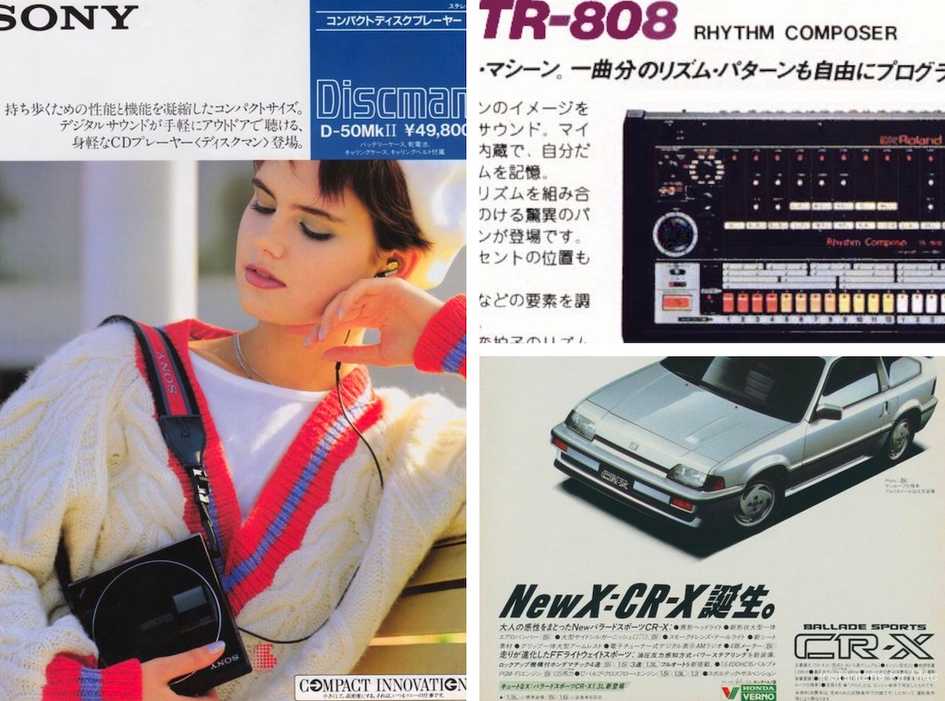
The technology that came out of Japan in the 80s made a lasting impact on music and culture worldwide. The Roland TR-808 drum machine, which helped spawn hip-hop, techno, and house music, was invented in Japan in 1980.
The Sony Discman, the world's first portable CD player, was invented in Japan in 1984. This was preceded by Sony's Walkman, invented in Japan in 1979. According to Pitchfork, the Walkman "had astounded the world. The combination of musical immersion and unlimited mobility was a genuinely new experience."
For music collectors, CDs produced in Japan were (and still are!) rare and coveted. Japanese imports often contain unique artwork, packaging, and bonus tracks. In the 80s and 90s, when record stores were at their height of popularity, flipping through rows of compact discs and encountering an unusual (and expensive) Japanese import left an impression.
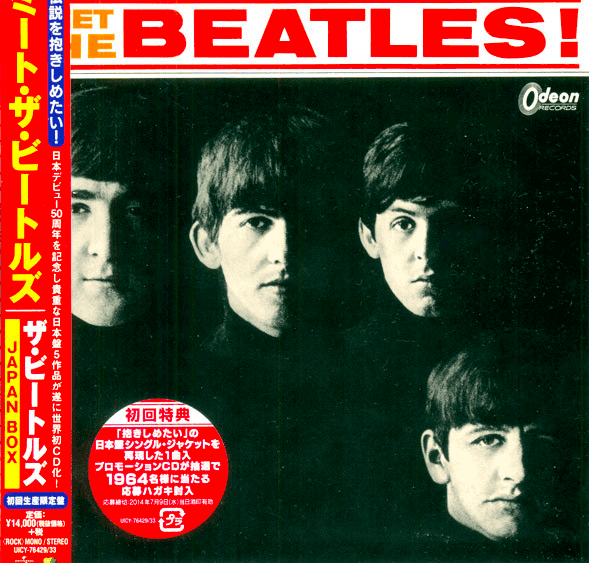
Aside from Japanese technology, consumer tech imported from other Asian countries left its mark on American culture as well. While the first boombox was invented by the Dutch brand Philips, the Dutch didn't produce the boomboxes that seeped their way into hip-hop videos, nor did they produce the boombox that John Cusack held over his head, playing Peter Gabriel's "In Your Eyes", to win over the girl of his dreams in the 1989 film Say Anything.
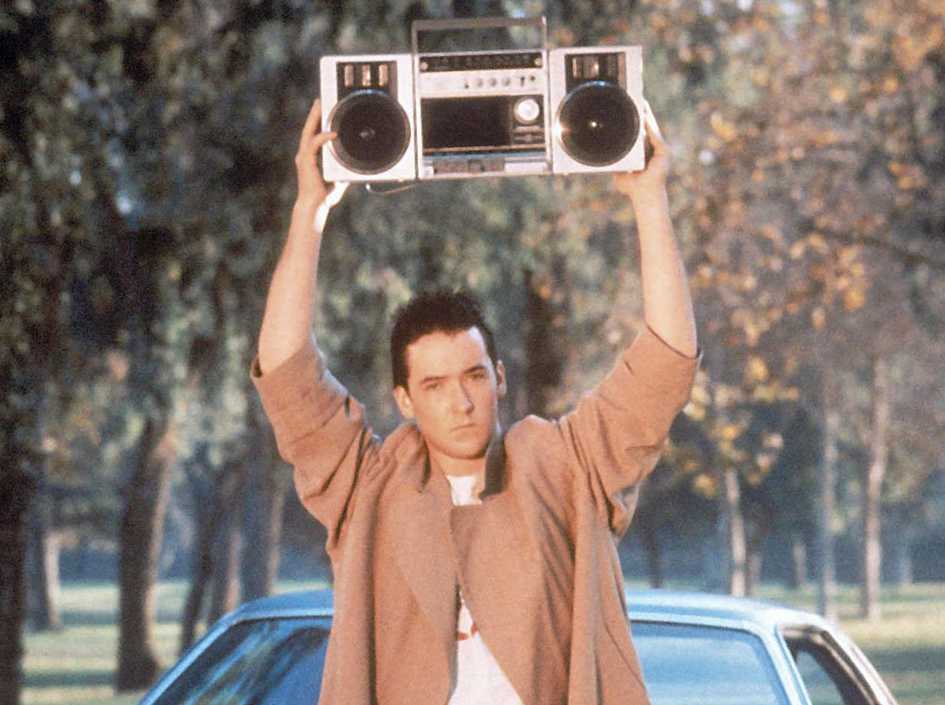
John Cusack's boombox was a Japanese-made Toshiba RT-SX1. Of the 3 boomboxes in the Smithsonian Institute's collection, one is Japanese (a Sharp HK-9000 owned by Fab 5 Freddy) and two are Korean-made (Tecsonic boomboxes, one owned by Public Enemy and one carried by Radio Raheem in the 1989 film Do the Right Thing).
Japanese text plays into a nostalgia for the 80s and 90s. When paired with vaporwave's sounds, Japanese text can transport the listener to a time when "Japan appeared to be the country that was building the future, one that looked shiny, new, and full of promise".
Is vaporwave racist?
The discussion about whether vaporwave is guilty of cultural appropriation (or worse) is vast. According to Bandcamp's blog, "vaporwave’s dependence on Asian characters can be seen as coming dangerously close to fetishizing the Other".
On a Reddit thread that asks "is vaporwave racist?", a very thought-out comment argues, "maybe, but vaporwave is definitely Orientalist". In other words, while vaporwave may not imply beliefs about racial superiority/inferiority, it does reinforces stereotypes and prejudices.
In the Journal of the Cultural Studies Association, author Lucy March writes that even if presented in a satirical manner, vaporwave could be responsible for "perpetuat[ing] harmful stereotypes" especially in regard to the objectification of Asian women through pleasing aesthetics.
What of the text that looks like this? Why does it so often accompany CJK characters in vaporwave? How does this fullwidth text relate to Japan? Does it also trigger nostalgia for lost futures?
Japanese halfwidth and fullwidth forms
To make the leap from John Cusack's Japanese boombox, to the unusually wide English letters found in track titles like Midnight on Main Street, 国内VIDEOshowcase, new romantic streams, fresh sip // 新 鮮 な 一 口, and 1992 - 空腹の目, we need to learn a little more about Japanese text encoding.
These stretched out English letters are called fullwidth and halfwidth characters. They have been around since the JIS X 0201 text encoding standard was introduced in 1969. This text encoding standard included 96 Japanese katakana characters, and 96 ASCII-like characters including English uppercase and lowercase letters.
These 96 English letters were designed to use the same amount of horizontal width as the katakana letters, to achieve visual consistency and readability alongside their Japanese counterparts.
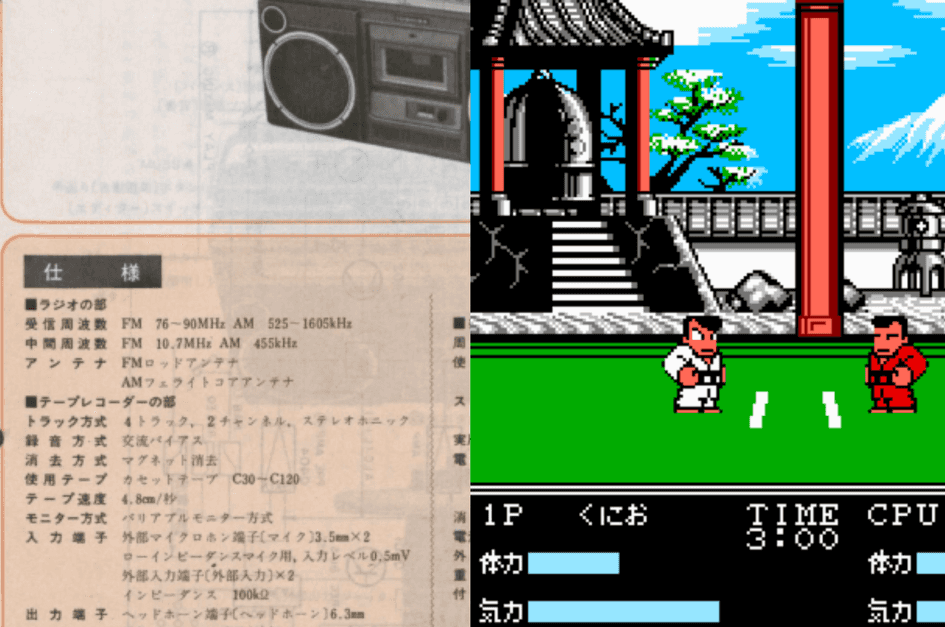
Fullwidth characters were used alongside Chinese, Japanese, and Korean characters, in print and digital media long before Unicode. In 1991, when the Unicode standard was created, these extra-wide letters were given their own Unicode block; known as "Halfwidth and Fullwidth Forms".
While fullwidth and halfwidth characters in vaporwave are often associated with Japanese, they also appear to have taken on a life of their own.
65% of vaporwave track titles with fullwidth characters, are not accompanied by any CJK characters at all.
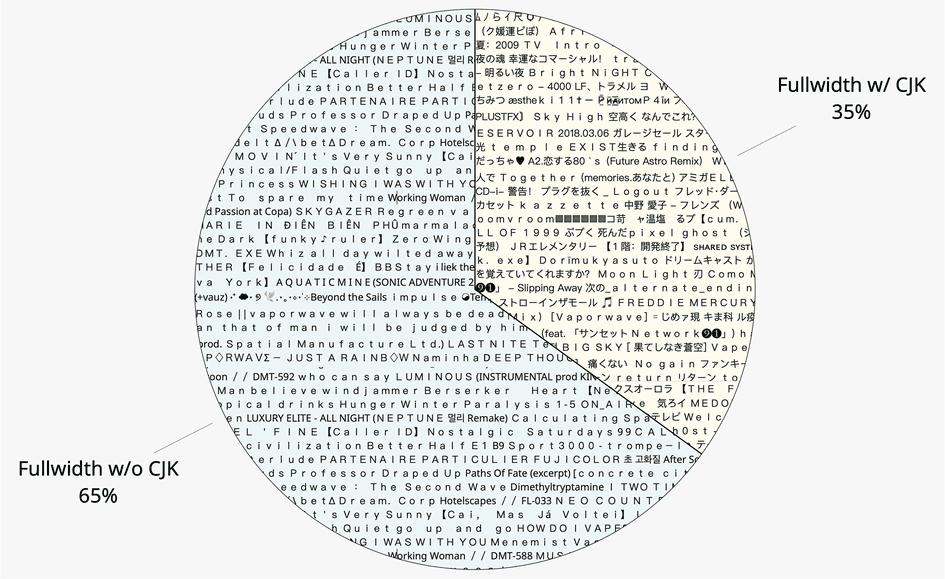
While the origins of spaced out letters are tied to CJK characters, stretched out letter spacing in vaporwave can also have connotations unrelated to Japan. Fullwidth can be tied directly to vaporwave's sounds, and the emotions that the music elicits.
Users in the r/vaporwave Reddit community have noted:
The use of spaces is meant to signify an alteration of intonation and emphasis. It means "I LIKE how this makes me feel" - reddit user
I would say the spaces represent the chopping up and slowing down of the samples used to make these songs. - reddit user absersta
I am pretty sure it's gotta do with the aesthetics of the earliest vaporwave songs in which they were stretched out and very reverb heavy. - reddit user AwesomeYears
A lot of vaporwave songs like to sample old elevator music, and timestretch it to make the tempo A L O T S L O W E R. - reddit user yepimthetoaster
The kerning could just be a result of the way the word is spoken, like a slow, distant, reverb-dripping whisper. - reddit use BrknTrnsmsn
Fullwidth text has become so entangled in vaporwave, that the word aesthetic itself, especially when written out in fullwidth characters, has an entirely different meaning. According to knowyourmeme, the word, when stylized in fullwidth characters is "a term that refers to retro-inspired visual art and music associated with the vaporwave subculture".
A quick aside on language, grammar, and Unicode correctness
You can ignore the people shaking their fists at the sky -- "aesthetic" can be an adjective, can be a synonym for vaporwave, can refer to vaporwave's aesthetic, or can refer to things that are simply beautiful. That sunset can be straight aesthetic.
Linguist, David Crystal said "Language has no independent existence apart from the people who use it. It is not an end in itself; it is a means to an end of understanding [society]."
If the rules for language bubble up from the people who use it, then so too, do the rules for Unicode. Fullwidth characters don't need to be used to accompany Japanese characters. And, 𝞛𝝙𝝉𝕙𝜀𝓂𝝰𝜯𝝸⊂∡ℓ characters don't need to be used for solving math problems. 🎤💥
Beyond fullwidth
Some vaporwave track titles don't use characters from the fullwidth Unicode block to achieve the stretched-out look. Instead they use regular Latin characters with spaces between them, to mimic the the fullwidth aesthetic.
In our analysis, we can spot these tracks by looking for text strings where close to 50% of the characters are spaces.
| char count | letter count | space count | percent spaces | |
|---|---|---|---|---|
| does this look like fullwidth | 29 | 25 | 4 | 4/29*100 = 13.7% |
| d o e s t h i s l o o k l i k e f u l l w i d t h | 53 | 25 | 28 | 28/53*100 = 52.8% |
The graph below highlights the use of spaces in vaporwave and synthwave track titles. We can see the bump in vaporwave track titles that contain ~50% spaces. These are the tracks that mimic the aesthetic of fullwidth characters, but using only Latin characters.

The trend of using extra space characters to mimic fullwidth isn't super common. It peaked in 2017, but is still in use.

Looking at how vaporwave artists use extra spacing is more interesting than looking at when in vaporwave's history the trend came about. Some vaporwave tracks push the creative boundaries of letter spacing much further. In our analysis, we found tracks that go to extremes, containing almost 90% spaces.
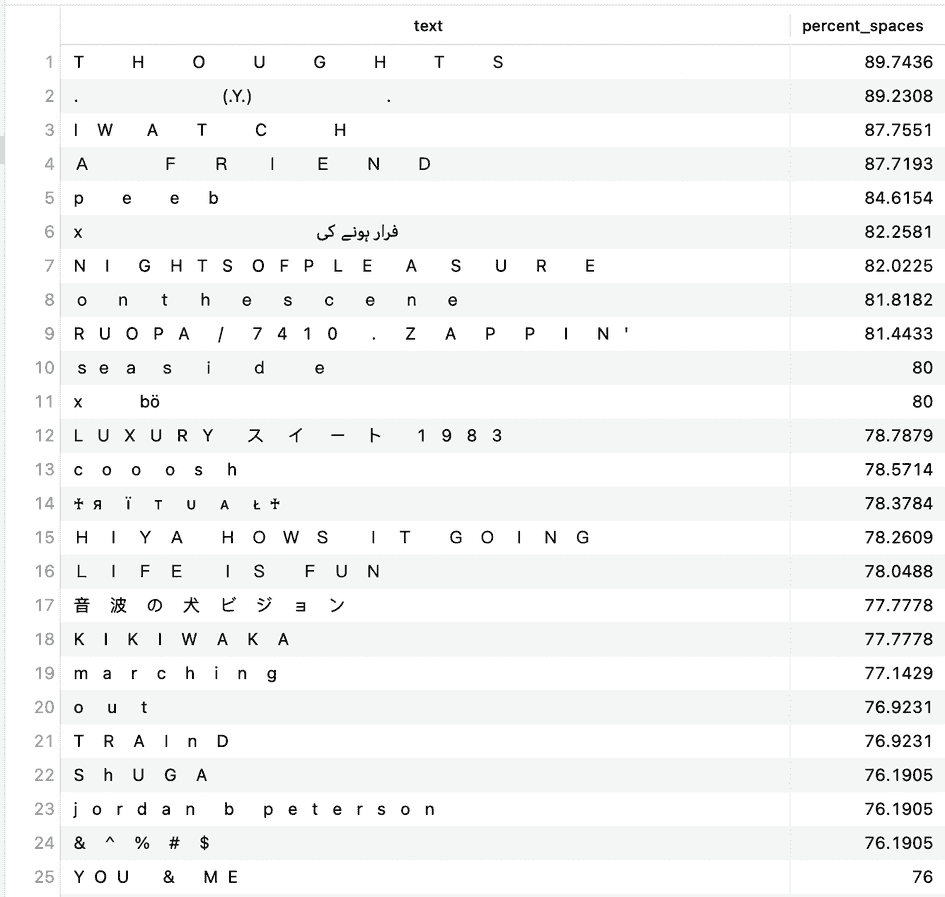
Unfortunately, this creative spacing doesn't render consistently across apps and browsers. As seen in the screenshot below, the Soundcloud mobile app does render the letter spacing in "SATURDAY MORNING" as the artist intended.
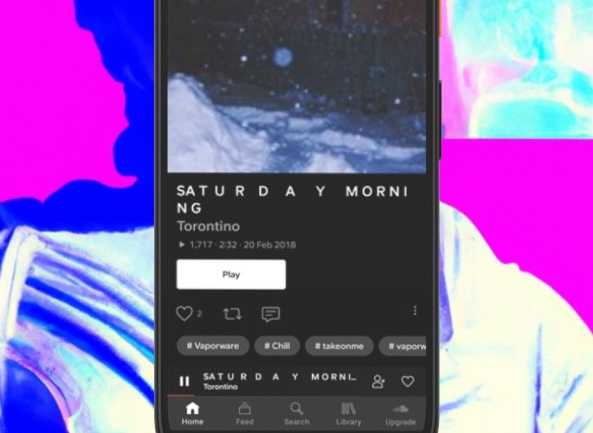
However... in web browsers, this spacing of the letters doesn't have the desired effect. This is because HTML ignores extra whitespace placed between words.
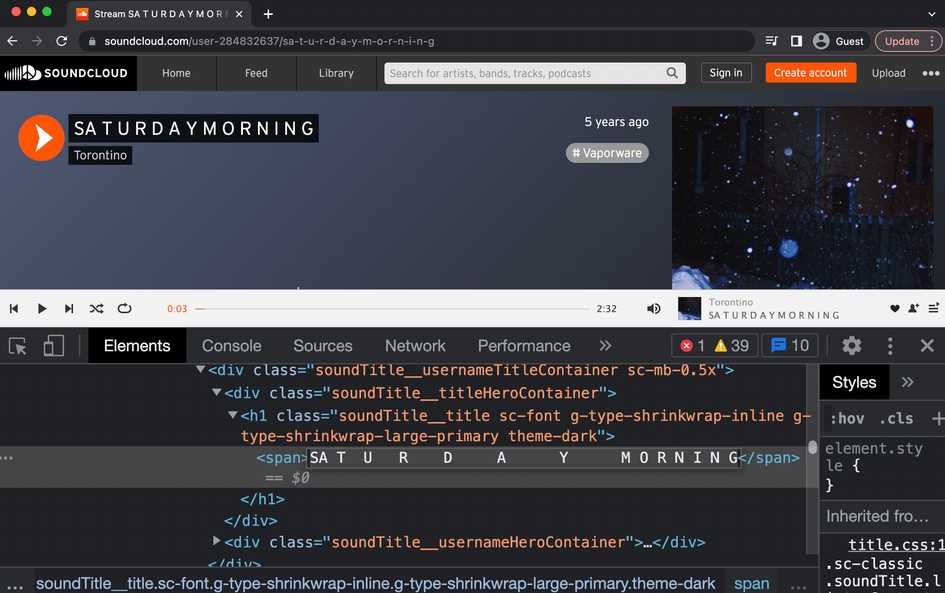
In order for this text to render properly in the browser, regular Unicode space characters U+0020 would need to be replaced with non-breaking space (aka nbsp) characters U+00A0. This is easier said than done. On the web, Soundcloud sanitizes nbsp characters, converting them into regular spaces. W o m p . W o m p .
༗ It's evident that fullwidth is no longer just being utilized in its original intended manner. Over time, the stretched-out letter aesthetic has evolved. While we wait for web browsers to catch up with the ways vaporwave art pushes the limits of Unicode text, we can only wonder, what's next‽ In the meantime, there are many other ways that vaporwave artists use text to unsettle us, evoke our nostalgias, and lose us in the vapor.
Corporate offices, malls, and the nostalgia factories™
Vaporwave's relationship with nostalgia is complex. Much of vaporwave engages with nostalgia directly, by simply sampling sounds and images produced in the 80s and 90s. This includes sounds and images produced not by artists, but by corporations; sounds that filled ordinary and unremarkable moments of the past with elevator music, weather channel jazz, and TV jingles.
Some vaporwave stops here, toying with our memories of the sounds in the background. Some vaporwave goes further though, commenting on how modern corporations also utilize nostalgia.
Today, corporations intertwine feelings for yesterday with sales messages, weaponizing nostalgia. Even the biggest of anti-capitalist skeptics is not immune to getting "the feels" from a well-crafted Superbowl ad. Baked into vaporwave art, is the recognition that nostalgia is a product, and that corporations are some of nostalgia's finest, most manipulative, craftsmen.

We can hear vaporwave's reimagining of music produced by corporate entities on albums like:
- REDEFINING THE WORKPLACE by INTERNET CLUB
- Creativity in the Workplace Part 1 by Azuresands大麻
- Welcome To Crystal Valley Mall by モールFUTURE/PAST
And on tracks like:
Other vaporwave works push their capitalist commentary further; imagining how a benevolent corporate overlord may one day rule our lives. The album Biosphere 0.2 by Cyber Surfer 3D takes place in a post-industrial future where oxygen is now produced by air production factories.
In vaporwave, some track titles and album names employ trademark ™, copyright ©, and registered ® Unicode symbols, corporate abbreviations (like inc., corp., ltd., etc.), and business language; to help comment on ideas around capitalism and nostalgia.
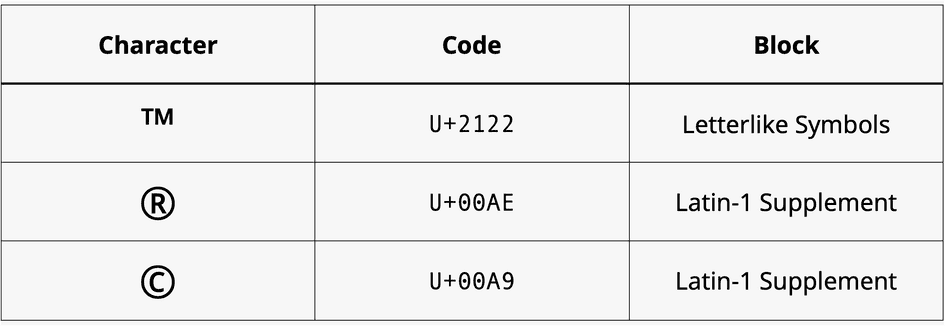
The chart below illustrates the preponderance of business-related Unicode characters and other corporate jargon in vaporwave track titles. The trademark character is the most common corporate symbol we came across, followed the the abbreviation "corp". As you might have guessed, these symbols appear in vaporwave more frequently than in synthwave.

Here are examples that make use of these symbols and abbreviations:
- Welcome to New World™ from New World™ by Nouveau Life™
- 100% Electronica™ Presents: "SOFTWARE - Island Sunrise" by ESPRIT 空想
- travel™ by FM Skyline
- Home Shopping Solutions™ from FUTURE VISION CONCEPTS ltd. by Jamie Bathgate
- レユニオン business . corp® コダック by KODAK
- Modern Romantic Lighting Solutions LLC by Digital Voyager
- New Dreams Ltd. by Laserdisc Visions
- 𝘚𝘰𝘧𝘵 𝘚𝘺𝘴𝘵𝘦𝘮 95 ©
- U L T R A L I T E © 19920 ltd.
One of the earliest analyses of vaporwave's relationship with capitalism is the widely cited "Vaporwave and the pop-art of the virtual plaza" by Adam Harper, published in Dummymag. Harper discusses if vaporwave is anti-capitalist satire, and whether it serves to accelerate capitalism toward "the insanity and anarchically fluid violence that is its ultimate conclusion".
Harper's article was published in 2012, when vaporwave was in its infancy. Since its publication, many have reacted by calling these sorts of vaporwave-is-a-commentary-on-capitalism analyses nonsense.
Well, are they? Redditor fancifuldaffodil called the article "super reductive and over-intellectualized", noting that "over confident positing of vaporwave as this grand capitalist critique was about as pretentious as writing on the topic gets".
Others say that vaporwave is only framed as a commentary on capitalism because of Harper's early analysis, and that Harper's lens was too narrowly focused. Reddit user _PS1 tells us to "blame Adam Harper for thinking [the James Ferraro album] Far Side Virtual was the end-all be-all of vaporwave themes."
Yes, Far Side Virtual was commentary on capitalism/consumerism... In an an interview, Ferraro said: "If you really want to understand Far Side, first off, listen to [Claude] Debussy, and secondly, go into a frozen yogurt shop. Afterwards, go into an Apple store and just fool around, hang out in there. Afterwards, go to Starbucks and get a gift card. They have a book there on the history of Starbucks-- buy this book and go home. If you do all these things you’ll understand what Far Side Virtual is-- because people kind of live in it already."
But what about vaporwave as a whole? Let's look at the data.
Harper's article was published in the same month that the vaporwave subreddit was created, prior to there being an established vaporwave community, and well before the genre peaked. When Harper was discussing vaporwave's relationship to capitalism, use of "corporate" text characters was rising. However, the vaporwave music and community that we know today, did not yet exist.
As vaporwave grew, the use of corporate symbols in track titles faded.

If the music of vaporwave reflects the genre's use of text, then Harper wasn't wrong -- but he was analyzing the genre in its infancy. The art form is not stagnant. Contemporary analyses of the genre need to broaden their scopes beyond critiques of capitalism. Vaporwave has many themes running through its veins; and many more ways to use Unicode.
Nostalgia.exe
Bits and pieces of outdated technologies frequently creep into the vaporwave aesthetic. This might be a reflection of our longing for the technology of a bygone era. Or... this might be a comment on, what Bandcamp's blog calls "the 21st century’s pretensions of being unparalleled in its technological sophistication". It's probably a little bit of both.
Track names, like the ones below, seem to reference technology products and brands from a bygone era -- even if some of these technologies never actually existed.
Other tracks take a different approach. They are named to appear as technological artifacts themselves. These track titles are written to look as if they were found on an old backup tape, or discovered on a dust covered PC laying dormant in the attic. To achieve this effect, vaporwave artists employ the tactic of incorporating file extensions into their track names.

Prior to Windows 95, vaporwave's darling operating system, PC users were accustomed to seeing file names followed by 3 letter extensions. File extensions helped users determine that SOLITAIRE.EXE was an executable file, README.TXT was a text file, and SYSTEM.INI was some sort of scary config file that you shouldn't mess with.
Here are examples of vaporwave tracks, albums, and artists that use file extensions:
- esprit.wav from the album virtua.zip
- A2.wmv
- DERELICTメガタワー by death's dynamic shroud.wmv
- 裏vaporwave無職.exe
- diana_ross.wav
- G_R_A_D_I_E_N_T___.TXT
- lesbian dating.AVI
- Arena Phantasy by m a g g i e . w a v
Nearly one in one hundred vaporwave tracks use file extensions to pay homage to the technologies of the past.

Furthermore, the specific file extensions used in vaporwave often belong to file formats that were at peak popularity in the 80's and 90's. Some are now obsolete.

Older extensions like AVI and WMV (introduced by Microsoft in 1992 and 1999, respectively) are more likely to appear, compared to modern formats like MP4 and MOV. Other extensions used are even more obscure, arcane, or ironic.
There are other "text tricks" that vaporwave artists employ, to make their works seem like technological artifacts from a lost future. For example...
ANSI & ASCII art
In the 80s and early 90s, before web access was easy to come by, the BBS was how tech-savvy folks connected. Users who dialed into bulletin board systems often encountered user interfaces, logos, and full blown art galleries made with ASCII and ANSI characters. ANSI art had become a well-established form of art by the time BBS reached peak popularity.
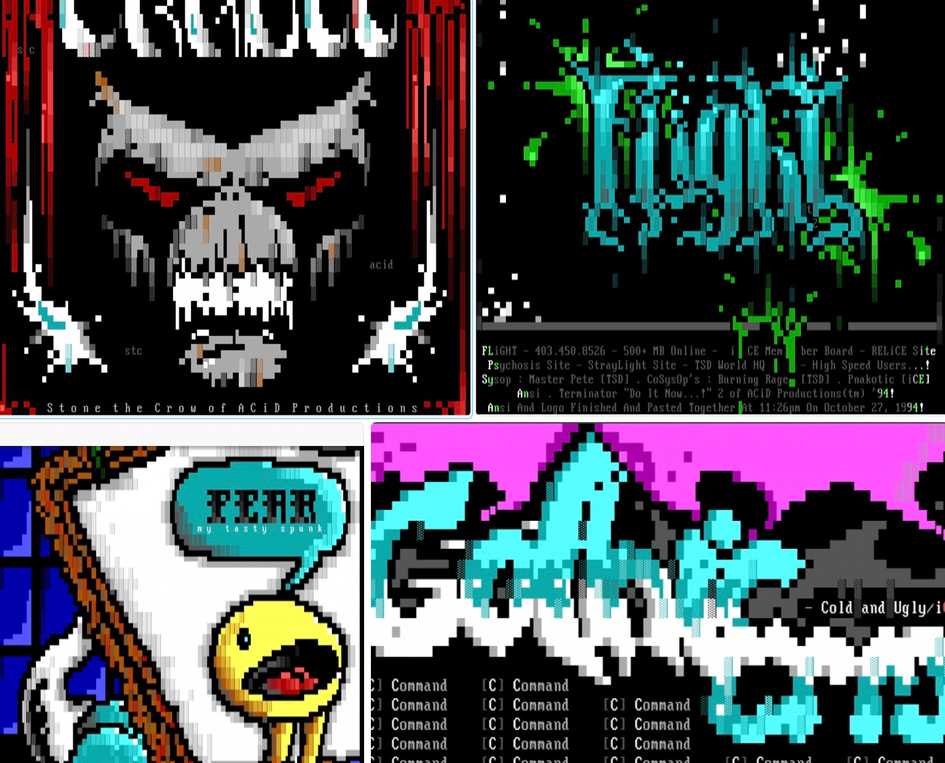
In 1993, AOL started mailing CDs to prospective customers and web access became more commonplace. This paved the path for the BBS's demise. Along with internet access, came a shift away from monospaced fonts in general. And so, ANSI and ASCII art's popularity began to fade.
While other forms of retro digital art (pixel art, MS paint, etc.) are more prevalent on vaporwave album covers, ANSI and ASCII art do exist within the genre.
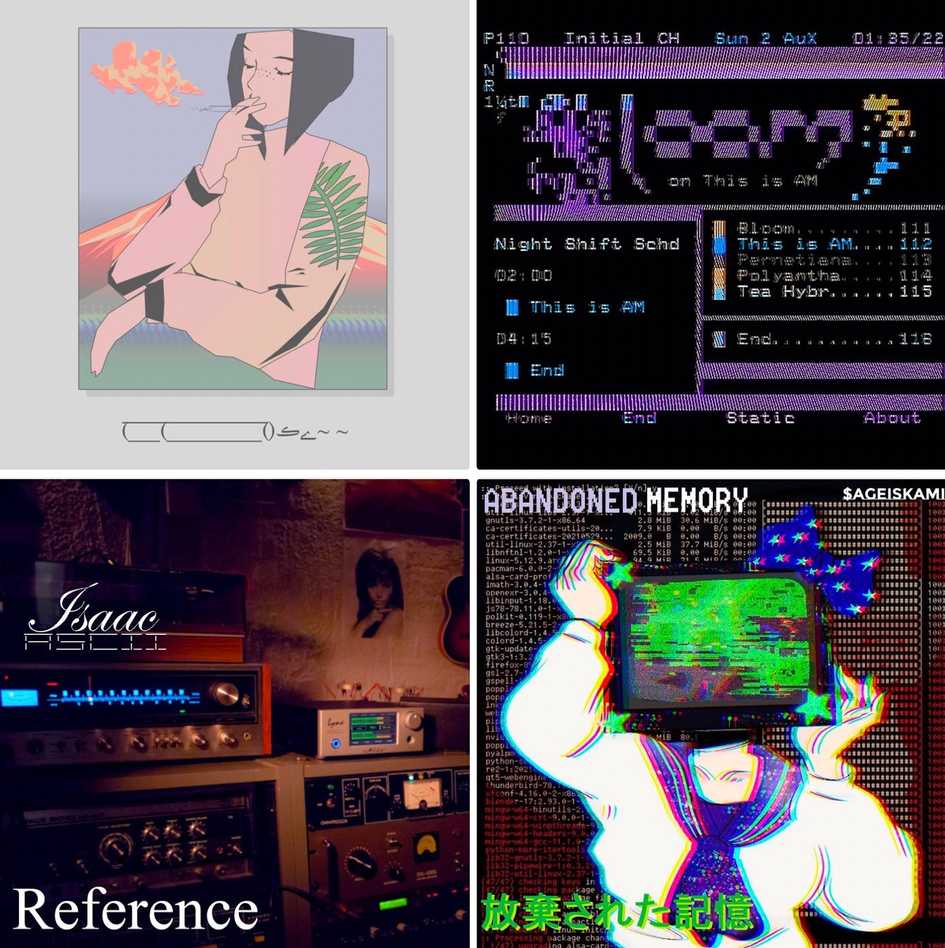
Vaporwave albums like †Nematophy by Windows96, Reference by Isaac Ascii, GLOOM by Nacre Repo, and ABANDONED MEMORY by $AGEISKAMI infuse ASCII and ANSI art into their designs.
ANSI art is also found in the description on Blank Banshee's YouTube channel.
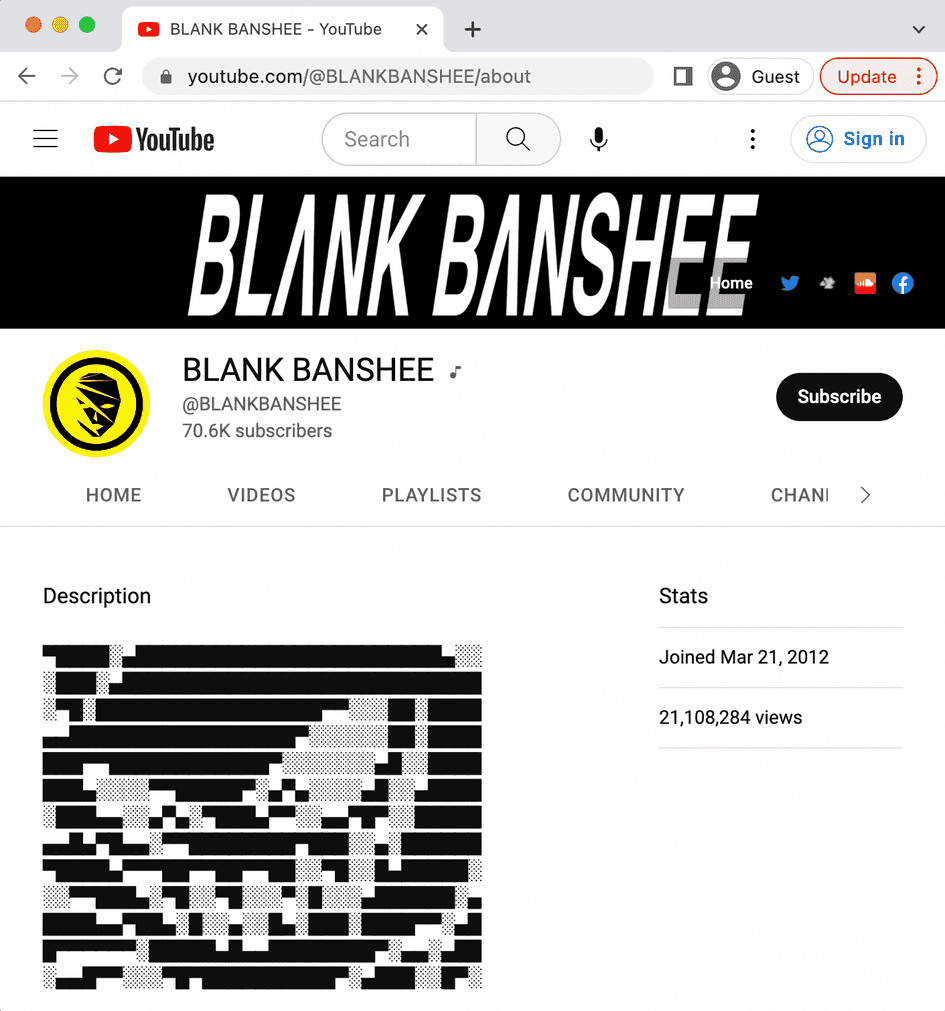
As we've been discussing, the vaporwave aesthetic isn't just limited to music and album covers. To reference the look of ANSI art, vaporwave artists incorporate text characters from the "Block Elements", "Geometric Shapes", and "Miscellaneous Mathematical Symbols" Unicode blocks into track titles -- transporting listeners to the days of ANSI, BBSes, and the late night beeps, hisses, and cracklings of 56k modems.
Here are some tracks that use Unicode to emulate the ANSI art stylings of the 80s and 90s:
- §E▲ ▓F D▓G§
- ▒▒▒▒▒▒▒▒▒▒▒▒▒▒▒?
- 1984 ░▒▓█
- ███▓▒░░.HIGHWAY PETROL.░░▒▓███ ▀▄▀▄▀▄▀▄▀▄▀▄▀ ▄▀▄▀▄▀▄▀▄▀
- Spend some time alone ░▒▓█【自分のための時間】█▓▒░
- 高速道路►►►
While only a small fraction of vaporwave tracks use these ANSI-looking Unicode block characters, it is clear that vaporwave makes use of them far more often than synthwave.

Japan in the 80s saw the emergence of kaomoji, which use Japanese characters alongside ASCII to form emoticons ( ͡• ͜ʖ ͡• ). These cute little text strings can be read without needing to tilt your head to the side. Kaomoji remain popular in Japan and throughout the world. They are also seen in vaporwave, on tracks like:
For what it's worth, the "Symbols for Legacy Computing" Unicode block most closely overlaps with the characters used to make ANSI art. However, this block is quite new. It was introduced in 2020, in version 13 of the Unicode standard. Vendor support for characters in this block is limited. Many of its characters don't render in web browsers or operating systems yet.
When did ANSI-ish characters start appearing in vaporwave? Are they gaining or losing popularity?
░▒▓ ANSI-looking ▓▒░ characters from the Block Elements block started becoming more common in vaporwave text in 2018. The fact that these Unicode characters are gaining popularity in vaporwave's twilight years could be a sign that the genre has yet to stagnate; vaporwave artists are still innovating.

Math ≠ 𝙼𝒂𝔱𝕙
Another set of characters that began showing up in vaporwave well past the genre's peak, are ones that look like 𝒯𝐇𝕀𝚂. These characters belong to the "Mathematical Alphanumeric Symbols" block. They were designed for use in mathematical notation, equations, and formulas.
For vaporwave artists (and pretty much everyone else on the internet), these characters are used to mimic bold, italic, monospace, and other text styles; on platforms that lack native text formatting tools. Copying and pasting these Unicode characters allows artists on sites like Bandcamp and SoundCloud to stand out and be more playful with their use of typography.
Here are some examples of vaporwave track titles that use these stylized letters:
- 𝙿 𝙸 𝚁 𝙰 𝚃 𝙴 𝚂 カリブ海の -𝘸𝘢𝘪𝘵 𝘵𝘪𝘮𝘦- 3hr 10min
- 𝘯𝘦𝘷𝘦𝘳 𝘦𝘯𝘥𝘪𝘯𝘨 𝘦𝘷𝘦𝘯𝘪𝘯𝘨𝘴
- ℝⒾsкㄚ ᗷ𝐄нÃ𝐯ισг
- 🐟𝐨𝓬𝕖คℕ '83🐟
- OASISスグが & ★𝓡𝓸𝓬𝓴𝓼𝓽𝓪𝓻★ - H O T E L 情報広告 (w/ MIDNIGHT 88.1 FM)
- 𝗹𝗶𝗹:𝘀𝗶ː 僅かな波の断片EP
On YayText, we've built tools that make it easy to stylize text using these characters. You can access them here:
| Style | Example |
|---|---|
| Serif bold | 𝐄𝐱𝐚𝐦𝐩𝐥𝐞 𝐭𝐞𝐱𝐭 |
| Serif italic | 𝐸𝑥𝑎𝑚𝑝𝑙𝑒 𝑡𝑒𝑥𝑡 |
| Serif bold italic | 𝑬𝒙𝒂𝒎𝒑𝒍𝒆 𝒕𝒆𝒙𝒕 |
| Sans-serif bold | 𝗘𝘅𝗮𝗺𝗽𝗹𝗲 𝘁𝗲𝘅𝘁 |
| Sans-serif italic | ���𝘌𝘹𝘢𝘮𝘱𝘭𝘦 𝘵𝘦𝘹𝘵 |
| Sans-serif bold italic | 𝙀𝙭𝙖𝙢𝙥𝙡𝙚 𝙩𝙚𝙭𝙩 |
| Script | ℰ𝓍𝒶𝓂𝓅𝓁ℯ 𝓉ℯ𝓍𝓉 |
| Bold script | 𝓔𝔁𝓪𝓶𝓹𝓵𝓮 𝓽𝓮𝔁𝓽 |
| Fraktur | 𝔈𝔵𝔞𝔪𝔭𝔩𝔢 𝔱𝔢𝔵𝔱 |
| Fraktur bold | 𝕰𝖝𝖆𝖒𝖕𝖑𝖊 𝖙𝖊𝖝𝖙 |
| Monospace | 𝙴𝚡𝚊𝚖𝚙𝚕𝚎 𝚝𝚎𝚡𝚝 |
| Double struck | 𝔼𝕩𝕒𝕞𝕡𝕝𝕖 𝕥𝕖𝕩𝕥 |
Like the ANSI-looking characters we previously discussed, the use of mathematical alphanumeric Unicode characters in vaporwave began in 2017 and starting picking up steam in 2018. The use of bold, italic, and other styles comprised from this block has yet to show signs of slowing.

Is vaporwave dead?
The changes over time in how vaporwave artists use fullwidth letters, Japanese characters, corporate symbols, characters from Unicode's alphanumeric math block, etc. are all signs of deeper changes within the movement.
To understand the full picture of how vaporwave has evolved, let's pair our analysis of the text with the insights of someone who's watched vaporwave unfold since day one.
Van Paugam is a Chicago-based DJ who works with 80s Japanese funk, disco, and city pop. He has been listening to vaporwave since 2010. Paugam has written multiple blog posts based on his "decade's worth of examining what goes on in the [vaporwave] scene", describing its transformation from 2010 to present day.
2010 - 2011
According to Van Paugam, the earliest days of vaporwave had a "spirit of innovation and experimentation". The sounds being produced were "almost anti-capitalist, Marxist interpretations of music that defied traditional expectations". At this point in time, the genre was "dripping with sincerity and curious flirtation with the potential for a new age punk mentality".
The genre's spirit of experimentation extended to text as well, as vaporwave artists began to explore ways that Unicode text could be manipulated. In vaporwave's infancy, artists used ™ symbols, CJK characters (構), and ▚block▞ characters. However, the vaporwave text style that we know today did not yet exist.
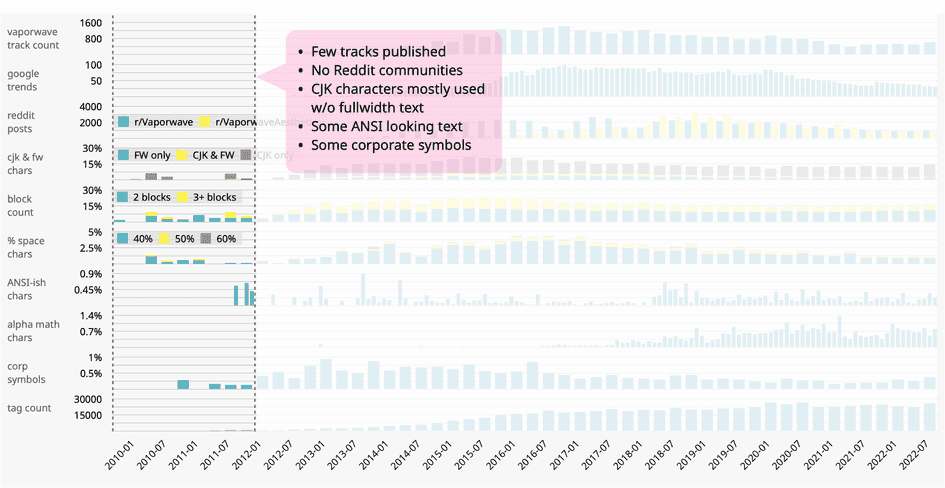
2012 - 2014
In the years following vaporwave's birth, the genre saw a clear rise in both popularity and artistic experimentation. Communities of listeners began to form, and according to Google search data, more people began to ask "what is vaporwave?".
The year 2014 was also the beginning of what Van Paugam calls vaporwave's "hyper-sensitive years" -- "when even just basic feedback would be met with hostility" and "everyone's artistic expressions, however deranged were 'valid'".
While some Unicode tactics still had more growth to come, these were the peak years for use of corporate symbols. Perhaps these were also the peak years for the expression of anti-capitalist notions within the genre.
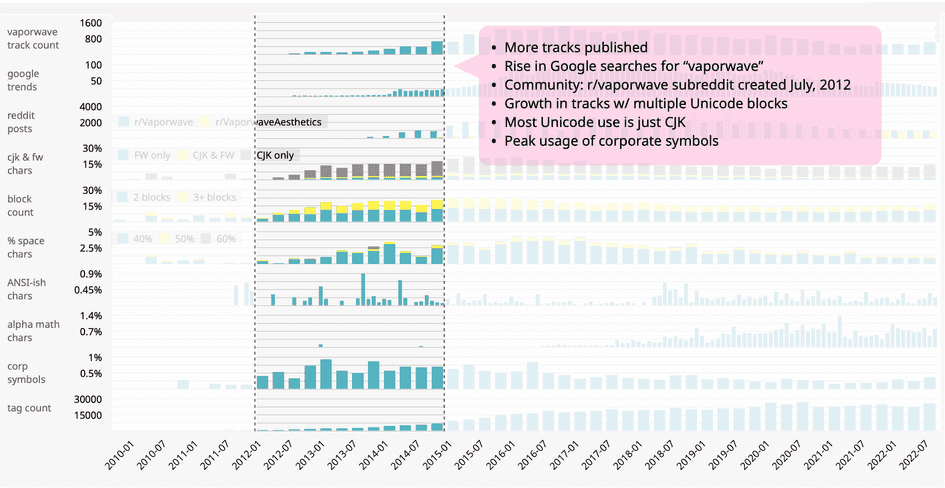
2015 - 2016
In 2015, vaporwave began to peak. While uploads to SoundCloud and Bandcamp were at an all-time high, artistic innovation slowed. Major publications chimed in: Esquire declared "vaporwave is dead", and Vice blamed the genre's death on Tumblr and MTV.
Vaporwave artists themselves also proclaimed the genre dead.
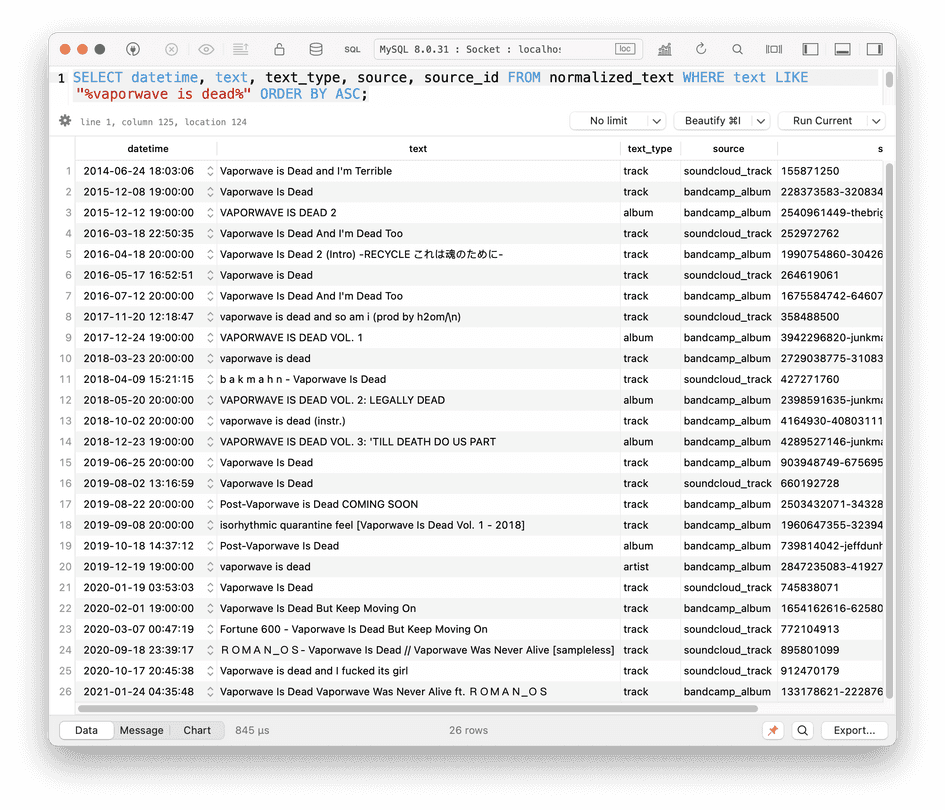
Use of Unicode symbols like ™ and © declined. According to Van Paugam, 2015 was when vaporwave artists began to "abandon any smidge of philosophical, anti-capitalist, or marxist tendencies." These are the years that vaporwave went mainstream, leading to "a corruption of its original ideals and philosophies regarding the sound and aesthetic".
During this same period of time, the r/VaporwaveAesthetics subreddit began to experience growth, reflecting a broader focus on a visual look that Paugam calls a "parasitic neon haze".
Tutorials for "how to make vaporwave" began to crop up on YouTube, and the aesthetic stopped evolving. Many tracks produced during this time period were "low effort", where the sampled music was simply slowed down.
This low level of creative effort can be seen in the cookie cutter use of Unicode as well. The "formula" for creating a track title -- with CJK and fullwidth text -- hit its peak in 2015. And, for the many artists who didn't know how to use fullwidth, the formula for sticking space characters between letters peaked as well.
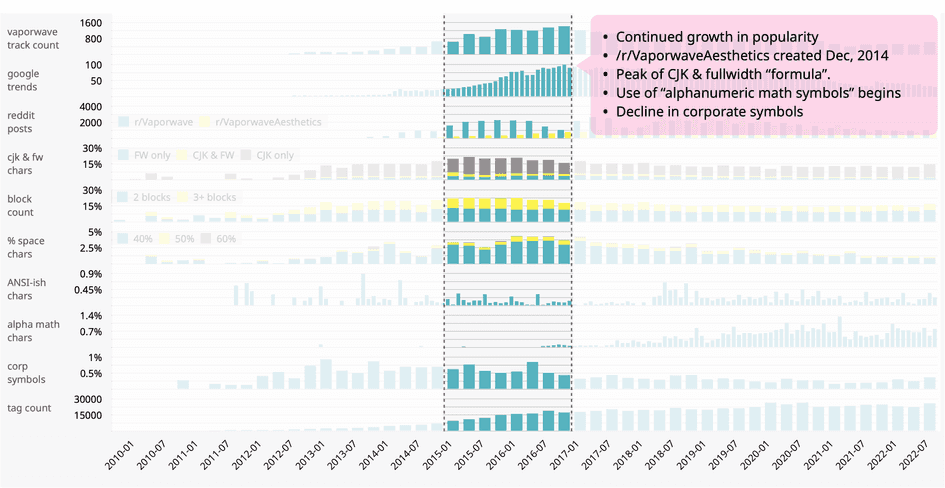
2017 - 2018
The year 2017 marked the beginning of vaporwave's musical decline, but not its death. Instead, the music and the visual components of vaporwave decoupled. According to Paugum, "vaporwave [became] all about its visual components rather than audio production quality".
While activity on SoundCloud, BandCamp, and r/vaporwave slowly decreased; the "aesthetic" saw increased activity. Visually-minded vaporwave communities like the r/VaporwaveAesthetics subreddit saw growth.
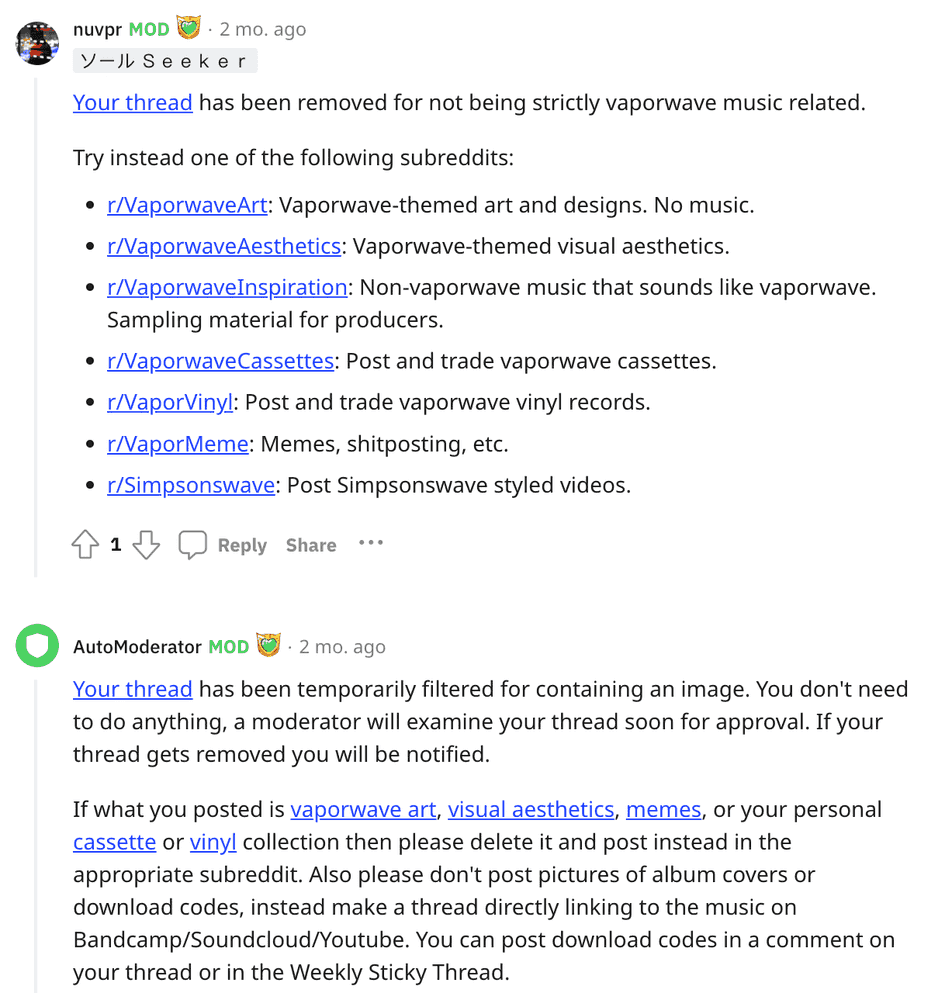
Vaporwave's visual renaissance created a renewed interest in experimenting with Unicode, especially in ways that were visually interesting. The years 2017 and 2018 saw growth in the use of Unicode characters that complemented the aesthetic, but had little to do with the philosophies of earlier vaporwave. ANSI-looking characters and mathematical alphanumerics became more popular.
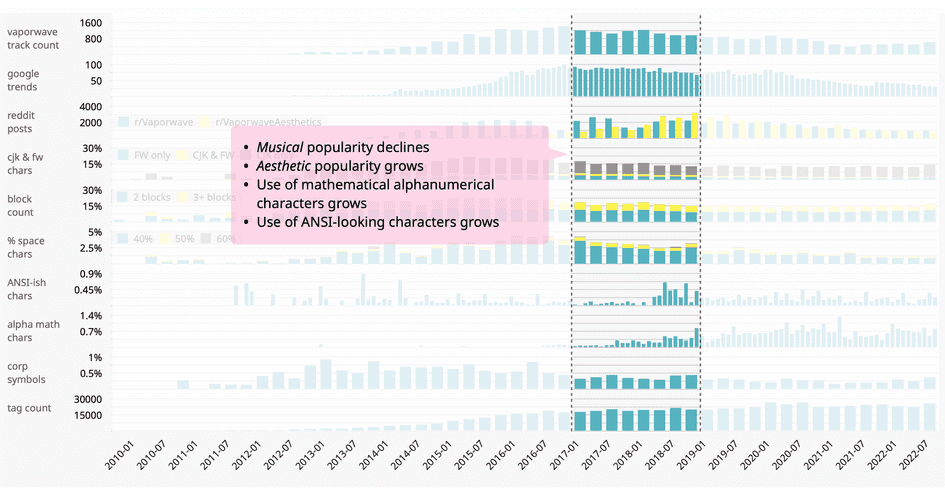
2019 - today
The decoupling of the visual from the music did nothing to ensure vaporwave's sustained popularity. In the past few years, there has been a significant decrease in Google search interest for vaporwave as well as a decline in visually-minded vaporwave communities like /r/VaporwaveAesthetics.
The period of renewed artistic experimentation with Unicode that began in 2018 did not last long. Use of alphanumeric math and ANSI-like characters remained constant, offering a slightly different flavor of the same Unicode text "formula" we saw in 2015.
While many vaporwave artists push back on the idea that the genre is dead; it has definitely changed. According to Van Paugam, today vaporwave is "a fractured mess but still glued together by a supergroup of producers and scenesters who will defend [it] to its bitter end."
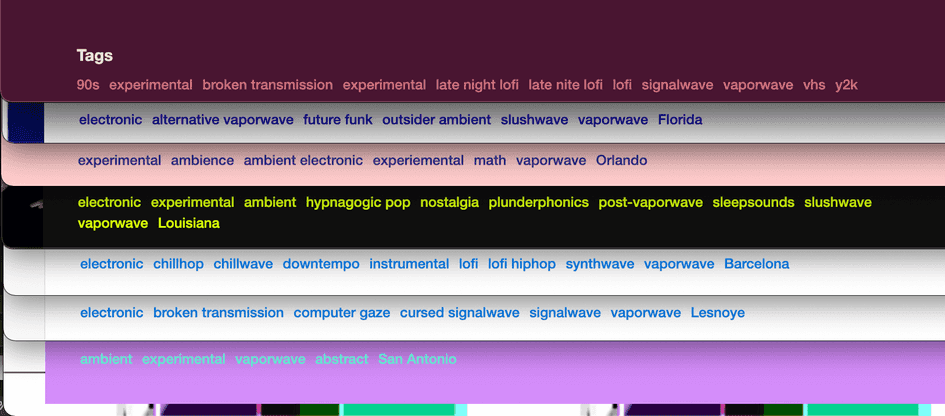
One phenomenon that has consistently exhibited growth from 2010 to the present, is the use of "vaporwave" as a tag on SoundCloud and Bandcamp. While it has become less common for musicians to list vaporwave as their primary genre, they have continued to use the term as a secondary tag for categorizing their music.
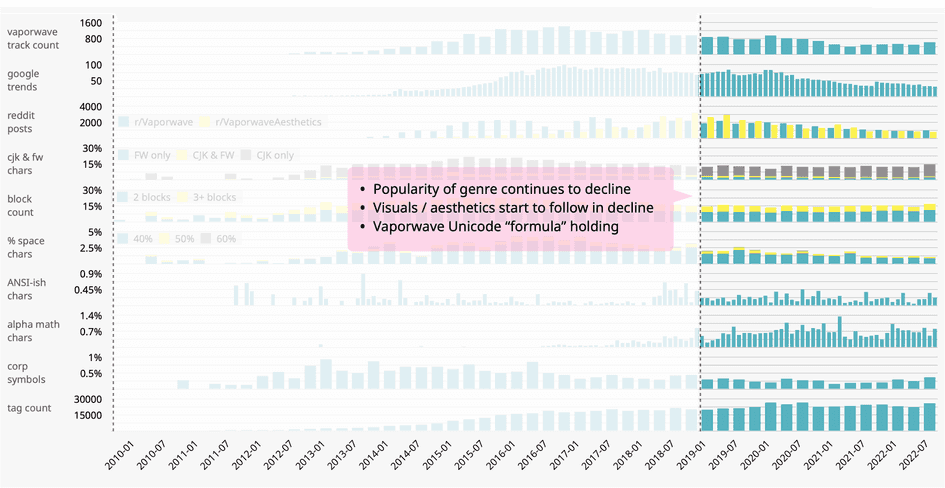
Perhaps, in the genre's death throes, "vaporwave" has become... an adjective.

Today, vaporwave's sound and aesthetic are predictable. If we stick the word "vaporwave" in a DALL-E prompt, we have a good sense of what the result will look like. Similarly, if we type text into one of the many "vaporwave text generators" available online (including our own), the result is also predictable® 組織
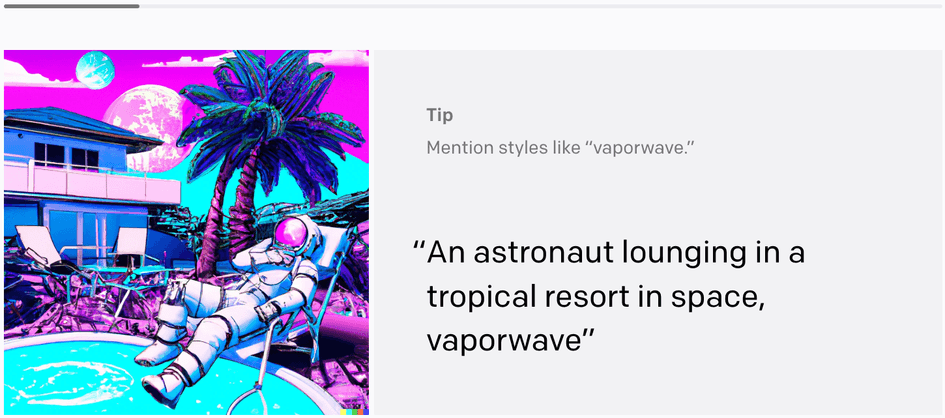
With Unicode's 327 blocks and nearly 150,000 characters, the text encoding standard is ripe for further exploration. Time will only tell if vaporwave can continue to serve fertile ground for that sort of experimentation. However, as long as artists have the ability to copy, paste, and play with Unicode text characters... making art with Unicode ພ९ꝆꝆ ਜ਼ລⳁⳁ౬৵. 🔚
We'd love to hear from you. You can find us at twitter.com/yaytext and facebook.com/yaytext. Let us know how you're liking YayText. If you have questions, please ask. Happy to help. Here's our privacy policy. Built by @varga © Yay Okay LLC 2025.
Follow @YayText